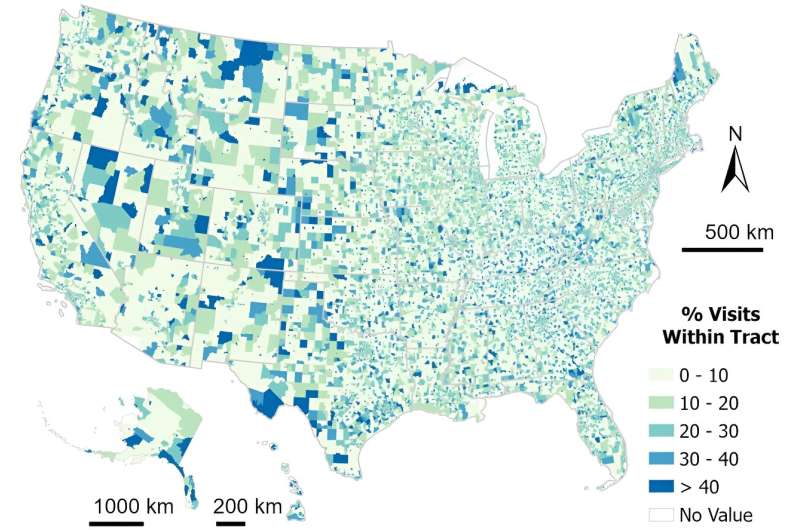This article has been reviewed according to Science X's editorial process and policies. Editors have highlighted the following attributes while ensuring the content's credibility:
fact-checked
peer-reviewed publication
trusted source
proofread
Nationwide study redefines how food environment impacts cardiometabolic diseases

Cardiometabolic disease (CMD) is an umbrella term that includes conditions such as obesity, diabetes, high cholesterol, and hypertension. Unfortunately, many adults in the United States have CMDs and the rates are on the rise. Now, researchers are working to understand the factors driving those increases by looking into geographical aspects of the food environment like the types and availability of food retailers nearby.
A collaboration between researchers from the University of Connecticut, Emory University, SUNY Albany, and the University of South Carolina has incorporated a vital component they think is largely missing from current food environment studies: namely, human mobility.
Their findings are published in Nature Communications.
Historically, it is believed that cardiometabolic diseases are inseparable from food environments, explains lead author Ran Xu, a researcher in UConn's Department of Allied Health Sciences.
"National agencies have used food environment measures, including the food access research atlas and the modified retail food environment index, as evidence when designing health initiatives and policy interventions to improve diet-related health outcomes," Xu says.
The problem with these environmental measures is that they are all location-based, such as summarizing the number of retailers in a neighborhood, which gives a limited picture.
"The underlying assumption is that people exclusively shop within that neighborhood, but we know that's probably not true, just intuitively," says Xu.
Many previous studies tried to link location-based food environment to diet-related health outcomes; for example, looking at the relationship between accessibility to fast food restaurants and obesity. The researchers noted that results from those studies were mixed and inconclusive. One critical variable missing in the past research is human mobility, or, more simply, where people shop for food.
"In this paper, we argue that human mobility is largely missing from previous research that just looked at the food environment in terms of the locations of brick-and-mortar stores," says Xu. "We incorporate the human mobility element into a nationwide study of food environment on a granular spatial scale, and that's the main contribution of our paper."
Co-author, principal investigator for the project, and Assistant Professor in the Department of Geography Peter Chen says this step is key, and novel. "This is the first time this mobile data has been used nationwide to study broad-scale food behaviors in the United States. There are other studies using mobility data to study the behaviors, but those studies are on the local scale and may have limited health and policy implications."
The researchers analyzed large-scale GPS tracking data, covering more than 94 million aggregated food store visits, and roughly 359,000 food retailers across the country. They used the tracking data to create a new index called the Retail Food Activity Index (RFAI) on the census tract level, where they determined the number of visits to food retailers and what proportion of the visits were to stores that sell fruits or vegetables, which are coined as "green retailers."
They found that on average, only 20% of the food retailer visits are within the half-mile boundary of residents' home census tract and most retail visits are far beyond the residents' immediate neighborhood. Then, the researchers looked at the health implications generated from this mobility pattern.
"We looked at the prevalence of obesity, high cholesterol, high blood pressure, diabetes, and coronary heart disease and how they were associated with different food environment indices," says Xu. "The activity-based index has a much stronger association compared with location-based indices, especially for obesity and high blood pressure. We also did many sensitivity analyses to make sure our results are robust, and they are robust."
"That speaks to the limitations of traditional location-based measures because if 80% of the food retailer visits are beyond one's residential neighborhood, then of course, you will not find much relationship between traditional food environment measures and health outcomes," says Xu.
The RFAI is a promising tool, and Chen says one of the anticipated lessons to take from the index is that policymakers need to think beyond grocery store placement when it comes to interventions.
"There is evidence showing that location-based policy initiatives called 'geographic levers,' including opening a new store or extending the opening hours of a store, have modest impacts on improving the health outcome of the local neighborhoods," says Chen. "Our data shows most people do not shop in their neighborhoods, and that is why the store-level intervention likely won't affect a neighborhood's health outcomes."
Chen adds, "The key point is just because you open a new healthy food retailer doesn't mean people will shop there. We think policymakers need to take that into account and find ways to improve people's neighborhoods, such as those where people do not often shop at green retailers."
Future studies will dig deeper into the policy implications of the new index and look more closely at why consumers don't shop at green retailers within their own neighborhoods in some places. They will also utilize other data such as consumer purchase information and large-scale surveys. The team hopes to collaborate with nutritional scientists and policymakers for future studies to work toward more reliable and effective policy interventions.
More information: Ran Xu et al, Integrating human activity into food environments can better predict cardiometabolic diseases in the United States, Nature Communications (2023). DOI: 10.1038/s41467-023-42667-8




















